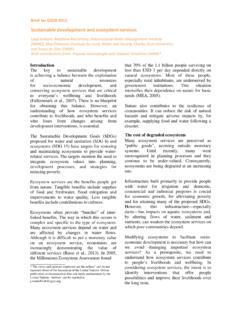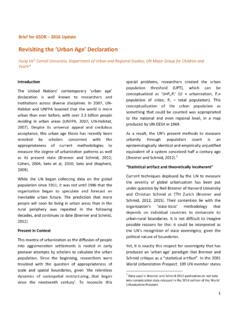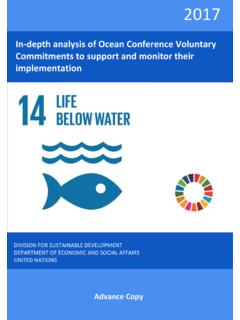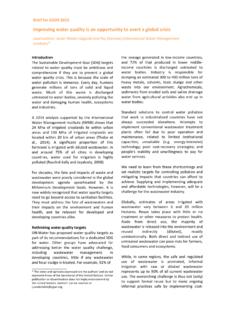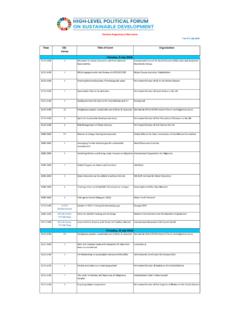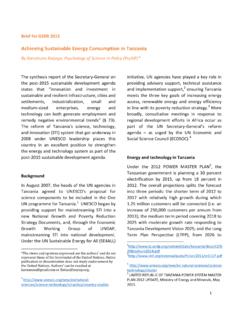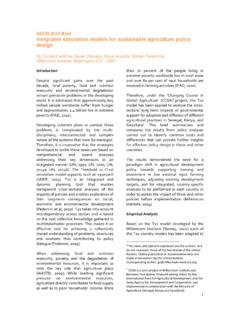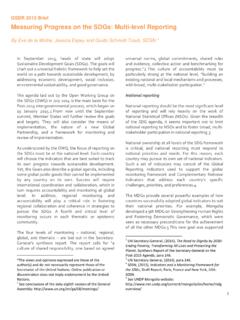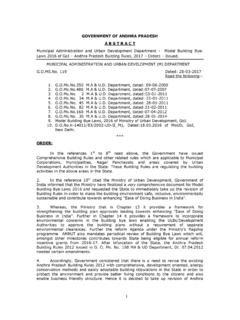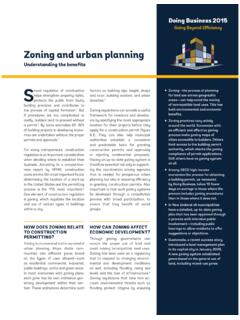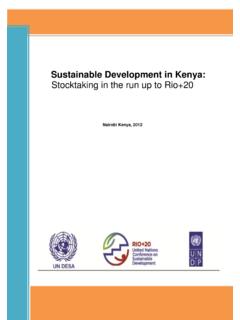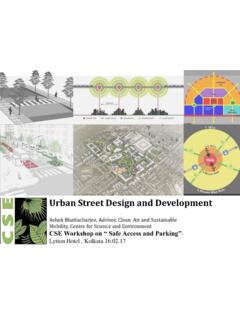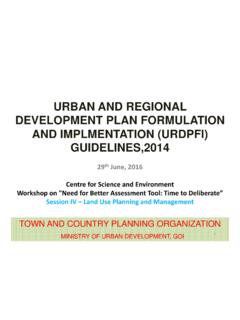Transcription of How transport affects poor people - United Nations
1 Poverty and sustainable transport How transport affects poor people with policy implications for poverty reduction A literature review Paul Starkey Consultant in integrated transport John Hine Consultant in transport planning October 2014. The views in this paper are those of the authors and they do not necessarily reflect the views of UN-Habitat, the Overseas development Institute (ODI) or SLoCaT. Table of Contents Acronyms and abbreviations .. 3. 1 Executive summary .. 4. 4. Rural transport and poverty .. 4. urban transport and poverty .. 7. 2 Introduction .. 9. 9. Research methodology .. 9. Research questions .. 11. Supply-side .. 11. Demand-side .. 11. 11. 3 Literature review: sources and issues.
2 12. Poverty and transport 12. Poverty and economic growth .. 12. A caveat: the origins of reviewed literature and authors .. 13. 4 Rural roads .. 14. Poverty, access and isolation .. 14. Agricultural production .. 15. Access to health care .. 16. Access to education .. 17. Non-equal benefits .. 18. Long-term benefits and negative consequences .. 19. Policy implications .. 19. Measurability of pro-poor benefits and investment priorities .. 20. Involving rural people in road construction and 21. Concluding observations on rural roads .. 22. 5 Rural transport services and intermediate means of transport (IMTs) .. 24. Access, proximity and mobility .. 24. Intermediate means of transport (IMTs).
3 24. 1. Motorcycle taxis and three-wheelers .. 25. Animal-drawn carts and two-wheeled tractor-trailers .. 26. Rural bus services, taxis, minibuses and passenger trucks .. 26. 6 Poverty, urban transport , urban growth and employment .. 29. The challenges of urbanisation .. 29. Decreasing urban density and its implications .. 29. urban traffic congestion .. 31. Road condition, construction and resettlement issues .. 32. Public transport .. 33. Employment and opportunities for the poor in urban transport construction .. 36. Direct employment opportunities in providing urban transport services .. 37. Participation in urban transport planning to address poverty 37. 7 Poverty and urban access.
4 40. Access to transport services, employment and other urban facilities .. 40. Access to basic facilities .. 40. Walking and cycling .. 41. Affordability of public transport .. 42. Trip distances, and travel time and the journey to work .. 43. urban transport for women and disadvantaged groups .. 44. 8 urban transport externalities and the poor .. 46. Road crashes .. 46. transport -induced air pollution and the effects on health and poverty .. 48. Effects of traffic congestion on the poor .. 49. Displacement of the poor resulting from transport projects .. 49. 9 Implications for pro-poor urban transport policies .. 52. 10 References cited and bibliography .. 53. 2. Acronyms and abbreviations ADB Asian development Bank Particulate matter up to AFCAP African Community Access Programme micrometres in size ( fine').
5 AIDS Acquired immune deficiency PMGSY Pradhan Mantri Gram Sadak Yojan syndrome (Indian road programme to connect all BRT Bus Rapid Transit villages). CBD Central Business District RED Roads Economic Decision (software). COHRE Centre on Housing Rights and RTS Rural transport services Evictions RTSi Rural transport services indicator DFID Department for International SLoCaT Partnership on Sustainable Low development , UK (UKaid) Carbon transport eg for example SO2 Sulphur dioxide EPWP Expanded Public Works Programme, SPARC Society for Promotion of Area South Africa Resource Centres FAO Food and Agriculture Organisation of SSATP Sub-Saharan Africa transport Policy the United Nations , Rome Program, World Bank, USA.
6 GDP Gross domestic product STAR Sustainable transport Appraisal Rating GIS Geographical information systems TRL transport Research Laboratory, UK. GIZ Deutsche Gesellschaft f r Tsh Tanzanian shilling Internationale Zusammenarbeit GmbH UITP International Association of Public GRSF Global Road Safety Facility transport (Union internationale des HDM4 Highway development and transports publics). Management Model UK United Kingdom (of Great Britain and HIV Human immunodeficiency virus Northern Ireland). h hour UN United Nations ICT Information and communication UN-Habitat United Nations Human Settlement technologies Program ie that is to say UNFPA United Nations Population Fund IFRTD International Forum for Rural USA United States of America transport and development USD United States Dollar ILO International Labour Organisation, VOC Vehicle operating costs Geneva WHO World Health Organisation, Geneva IMT Intermediate means of transport IRAP Integrated rural accessibility planning IT Intermediate technology (although IT.)
7 transport is now a name not an acronym). km kilometre LAMATA Lagos Metropolitan Area transport authority LGED Local Government Engineering Department, Bangladesh m million MDB Multilateral development bank MDG Millennium development Goals MUIP Mumbai urban Infrastructure Project MUTP Mumbai urban transport Project NGO Non-governmental organisation NO2 Nitrogen dioxide OECD Organisation for Economic Cooperation and development ODI Overseas development Institute PM10 Particulate matter up to 10. micrometres in size ( coarse'). 3. 1 Executive summary Background This review of the poverty implications of urban and rural transport was requested by the Partnership on Sustainable, Low Carbon transport (SLoCaT), contracted by UN-Habitat and implemented by the Overseas development Institute (ODI) with funding from UK Department of International development (DFID).
8 The research questions concerned the extent to which the poor can participate in the transport sector, benefit from transport , and be adversely affected by transport externalities. About 360 documents were reviewed, most in English. A significant proportion of the documents were produced by, or in association with, a relatively small number of international and northern' development agencies, including multilateral development banks (World Bank and ADB) and DFID-supported research programmes. Rural transport and poverty Importance of connecting rural people to reduce the poverty of isolation Many of the world's poor people live in rural areas isolated by distance, terrain and poverty from employment and economic opportunities, markets, healthcare and education.
9 Lack of basic infrastructure (paths, trails, bridges and roads) and access to transport services makes it difficult for poor people to access markets and services. There is clear evidence that rural isolation is associated with low agricultural productivity (linked to poor market access and low use of fertilizers and modern agricultural technologies). It is also linked with poor health (for example unnecessarily high peri-natal mortality) and low school enrolment. Rural isolation can imprison the elderly and people with disabilities. Twenty years ago, little attention was paid to the poverty implications of transport investments: it was assumed that investments in urban and rural roads stimulated economic growth and social development .
10 Recent research has shown that transport investments tend to benefit the non-poor'. most, and that investments must be consciously designed to avoid further impoverishing poor people . Where transport investments have stimulated economic growth, the poor have often benefitted only marginally in many cases, they have not had the resources to take advantage of the opportunities afforded by better access. Good transport infrastructure is a necessary condition for economic growth and poverty alleviation, but transport investments alone cannot address the problems of the poorest households. The main way rural people access markets and services is through roads that connect rural communities to market towns (in some regions waterways are also important).

